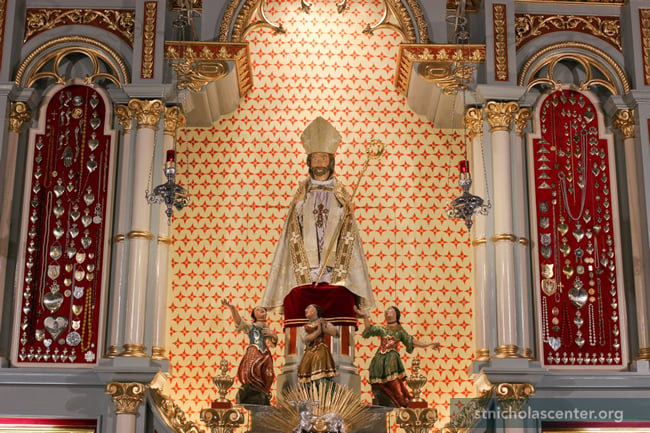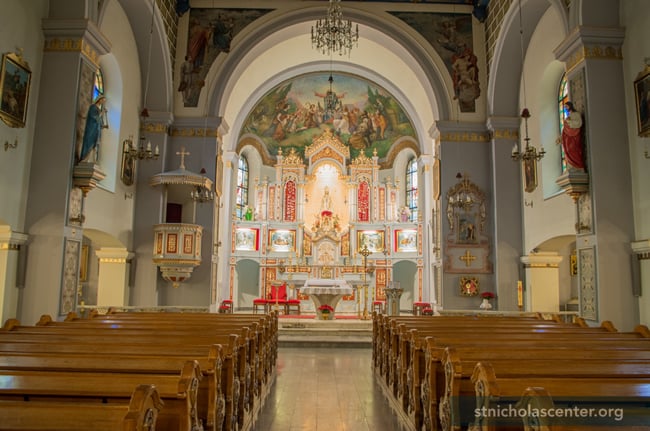Pilgrimage Shrine in Poland
Sanktuarium sw. Mikolaja, Piersciec
 Postcard: St. Nicholas Center Collection |
The St. Nicholas Shrine in Piersciec is one of the most important pilgrimage sites in Poland. Thousands of pilgrims come from Poland, Romanian Bukovina, Czech Republic and Ukraine.
The primary pilgrimage days are the last Saturday before the first Sunday in Advent, the Sunday after December 6, and the Sunday before June 24. However, pilgrims come at other times, especially during Advent until after the first of the new year.
Pilgrims come particularly on the Saturday before the first Sunday in Advent because the statue is brought down from the high altar and pilgrims may rub the its back with cloth. The back of the statue is worn as a result of this activity over many years. Many believe the statue, and cloth that has touched it, has healing properties. However, the priest says, "The figure does not heal. It is faith that works miracles."
The statue was carved by a shepherd in the early 16th century. Legend tells of the shepherd, Nikolai, who was good at whittling and carving, who found a fallen lime tree. He trimmed all the branches off and had a fine block of wood. He wasn't sure what to carve. But, after prayer, it came to him to carve his patron saint, St. Nicholas. Carving the figure consumed him for four years. During that period he had no time to carve buckets and other kitchen utensils which had provided him with additional food.
Nikolai carved in a shed and when the statue was finished people thought the shed was on fire as such an intense light came from it. However, they discovered that the light came from the statue which glowed as if it were burning, but it was not. The statue was placed at the crossroad where it helped people find their way and discouraged brigands.
All did not go well for the statue following the Reformation when such things were frowned upon and outlawed. Several times it was moved to the despair of the local residents. Each time it reappeared, back in its usual place and glowing. Finally, the order was to chop it up. The legs and arms were chopped off and it is said that blood flowed where the limbs were severed. Thrown into the water, the statue still reappeared in place, though diminished without limbs. When the statue was placed inside the church it was given a velvet robe to hide its disfigurement.
A chapel dedicated to St. Nicholas had been built Piersciec in the 14th century. It burned completely in 1616, though the wooden statue of St. Nicholas did not burn. The church was rebuilt in 1618. It was again dedicated to St Nicholas, which was very unusual as Lutherans, who were in control at the time, did not often dedicate a church to a saint. One hundred years later the church was once again Roman Catholic.
About 200 years ago the custom developed to dress the statue in robes the color of the liturgical seasons; this custom continues to this day. In 966, the year of the Millennium of the Baptism of Poland (the introduction of Christianity), relics of St. Nicholas were received from Bari, Italy.
 Photo: Sanktuarium Sw. Mikolaja, permission pending |
 Photo: Sanktuarium Sw. Mikolaja, permission pending |
Pilgrims come seeking aid for every need, especially health and often for children. There are many stories telling of healing from various conditions. The priest tells pilgrims, especially children, stories about St. Nicholas. He has also written a book of St. Nicholas songs with catchy tunes and simple words.
On the Regional Day of Reconciliation (the Saturday before the first Sunday in Advent) dozens of pastors and parish groups, and local authorities come together for a service of prayer and thanksgiving. Special St. Nicholas statues are awarded, with a rose and certificate, to those who have given exceptional service to God and humanity.
Sources
Sanktuarium Sw. Mikolaja.
Apostolstwo Dobrej Smierci.
"Swiety Mikolaj mieszka w Piersccu," TravelPolska.
back to top

